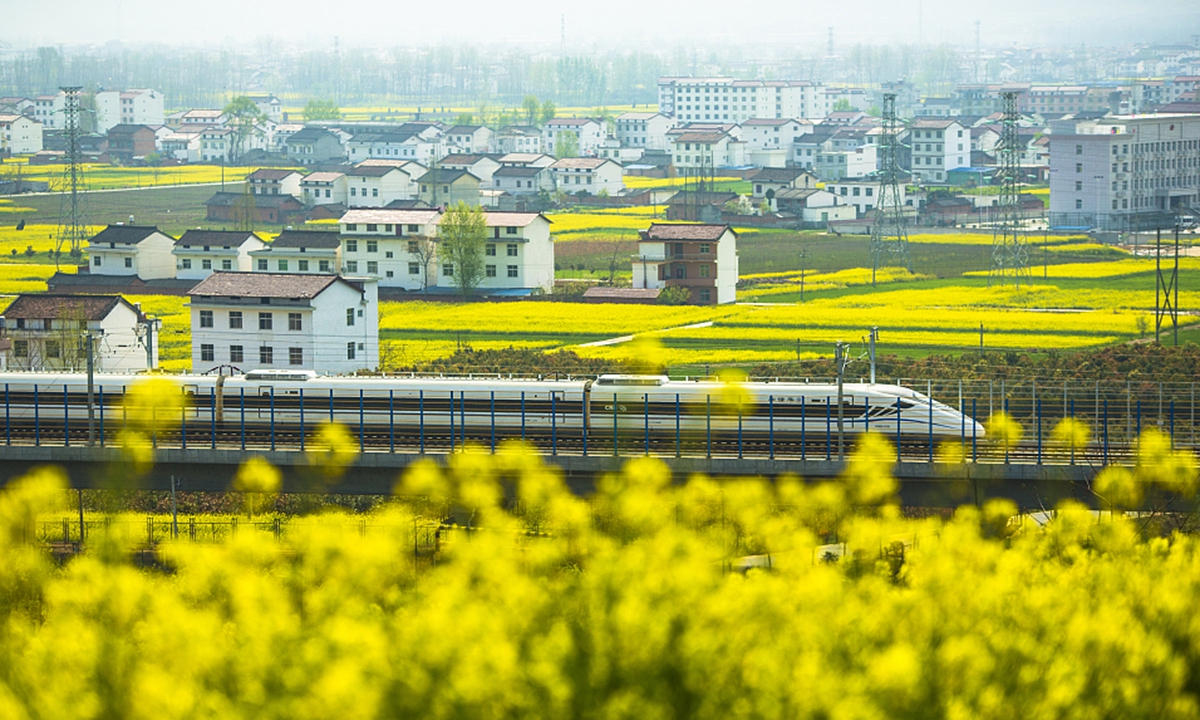A closer look at ‘Five-Year Plan’ system: a code to China’s stable and continuing development
By Huang Lanlan, Shan Jie and Li Qiao Source: Global Times Published: 2020/10/29 20:38:40

A high-speed train runs passed a town. Photo:VCG
The proposals of the Communist Party of China (CPC) Central Committee for the 14th Five-Year Plan (2021-25) were approved at the just-concluded Fifth Plenary Session of the 19th CPC Central Committee on Thursday. The top-level policy blueprint is expected to comprehensively guide the country's development in almost all sectors for the five years to come and beyond, once it is approved after a formal process.As a major feature of China's governance system since the 1950s, the Five-Year Plan is generally created every five years to set development targets across various sectors and make policies in accordance with those goals.
It reflects the long-term and big-picture views of the CPC as China's ruling party in developing direction for the whole country, enabling the world's second-largest economy to maintain relatively stable and consistent development in the face of changes in the world system through time, political experts said.
"Different from a few Western politicians who make self-interested, shortsighted policies, China's Five-Year Plan focuses on comprehensive and sustainable growth that has benefited and will continue benefiting all its people," Party construction and education researcher Dai Yanjun, a professor with the Party School of the Central Committee of the CPC, told the Global Times Wednesday.
The Five-Year Plan system has shown its unique advantages in coordinating growth in various regions and sectors through decades of practice and self-improvement. The advantages are particularly shown in its implementation, where authorities at all levels can fully pool together and mobilize resources to accomplish a certain goal within a certain period of time, Dai said.
"This is a very effective way to complete some large, nationwide projects in such a big country with 1.4 billion people," he commented.
Su Wei, a professor at the Party School of the CPC Chongqing Municipal Committee, shared how the Five-year Plans have guided regions in China to shake off poverty and gradually reach a higher standard of living.
In 1992, during the visit to South China, Deng Xiaoping noted that China should have coastal regions to become rich first, and then aid the central and western regions. This approach became part of specific Five-year Plans and was conducted step by step.
After a decade of development, the 10th Five-Year Plan (2001-05), under the instruction of the Scientific Outlook on Development, started to work on reducing the development gap among regions. Regional development gaps largely shrank in the following 15 years with many policies such as "Home appliances going to the countryside." Until the 12th Five-Year Plan (2011-15) and the 13th Five-Year Plan (2016-20), China has focused on pushing to build a moderately prosperous society in all respects.
Another key sector is China's environmental protection efforts.
At the first years after the reform and opening-up, China's main focus was still on guaranteeing access to food and clothing, and many factories caused pollution. Then during the 10th Five-Year Plan (2001-05), after the economy has developed fast, these factories were closed, and environment protection was put on the agenda. Environment protection became an index to evaluate local officials and the government, along with GDP growth.
In recent years, environmental protection and carbon emission reduction have become significant parts of China's development, and is expected to play a more important role in the upcoming 14th Five-Year Plan period.
It is never easy to keep doing what one says particularly in terms of national development and people's livelihood, Dai said, mentioning that some foreign politicians like to make empty promises that they seldom realize in their terms.
"China's Five-Year Plan, by contrast, is a disciplined system which clearly makes public its detailed targets and implementations, subject to supervision of all Chinese people," Dai told the Global Times.
Compared with capitalism, no matter monarchist, Keynesian or neoliberal, China's policies have advantages as shown in the Five-Year Plan system. According to Su, first, China's plans are made as an instruction, which is both formal and flexible; second, the state-owned companies and financial system means they could firmly conduct the plan for development in a more streamlined way.
Newspaper headline: People’s plan
Posted in: IN-DEPTH